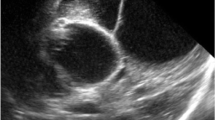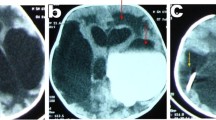Abstract
Purpose
The purpose of this paper was to study the feasibility of endoscopic third ventriculostomy (ETV) as a treatment modality in patients with hydrocephalus of tubercular origin.
Materials and methods
Literature on ETV in hydrocephalus of tubercular origin has been reviewed, and we have gathered experiences of neurosurgeons from various institutions in our country practicing ETV.
Results
Hydrocephalus, a common complication of tubercular meningitis, may be of communicating type or of obstructive variety. The communicating type is treated by medical therapy in 70–92% cases, whereas the obstructive type requires surgical intervention. The outcome of surgery depends upon gradation of disease. Shunting however has been a nightmare for neurosurgeons treating such patients (Smyth et al., Pediatr Neurosurg 39: 258–263, 2003). The shunts tend to get blocked with debris. Having found ETV as a successful modality of treatment in obstructive hydrocephalus of other etiology, neurosurgeons have attempted it in hydrocephalus of tubercular origin. Though various authors have had a success rate of 65–68%, failure has been quite high in acute cases due to thickening of the floor of third ventricle and distorted anatomy. The success rate is higher in chronic and burnt out cases.
Conclusion
Tubercular meningitic hydrocephalus is difficult to treat endoscopically as compared with other forms of meningitic hydrocephalus and requires adequate expertise and experience, especially in acute cases. Therefore, one would be justified in avoiding the use of ETV in acute cases and wait till patient presents with a failed shunt. Use of ETV in subacute and chronic cases seems to be justified as the first line of treatment.
Similar content being viewed by others
References
Agrawal D, Gupta A, Mehta VS (2005) Role of shunt surgery in pediatric tubercular meningitis with hydrocephalus. Indian Pediatr 42:245–50
Bhagwati SN, Parulekar G (1984) Management of TBM hydrocephalus—role of shunt surgery. Nimhans J 2(1):55–58
Bhagwati SN, Singhal BS (1971) Raised intracranial pressure in tuberculous meningitis. Proceedings of 3rd Asian and Oceanic congress of neurology. Neurol India 20(Suppl 1):80
Bhagwati SN (1971) Ventriculo-atrial shunting in tuberculous meningitis with hydrocephalus. J Neurosurg 35:309–313
Brockmeyer D, Abtin K, Carey L, Walker ML (1998) Endoscopic third ventriculostomy: an outcome analysis. Pediatr Neurosurg 28:236–240
Chakraborty AK (2000) Estimating mortality from tuberculous meningitis in a community: use of available epidemiological parameters in Indian context. Ind J Tub 47:9–13
Cinalli G, Sainte-Rose C, Chumas P, Zerah M, Brunelle F, Lot G, Pierre Kahn A, Renier DJ (1999) Failure of third ventriculostomy in the treatment of aqueductal stenosis in children. Neurosurgery 44:448–454
Farinha NJ, Razali KA, Holzel H, Morgan G, Novelli VM (2000) Tuberculosis of the central nervous system in children: a 20 year survey. J infection 41:61–68
Figaji AA, Fieggen AG, Peter JC (2007) Endoscopy for tuberculous hydrocephalus. Child’s Nerv Syst 23:79–84
Glynn JR (1998) Resurgence of tuberculosis and the impact of HIV infection. Br Med Bull 54:579–593
Hopf NJ, Grunert P, Fries G, Resch KDM, Perneczky A (1999) Endoscopic third ventriculostomy: outcome analysis of 100 consecutive procedures. Neurosurgery 44:795–806
Husain M, Jha D, Vatsal DK, Thaman D, Gupta A, Husain N, Gupta RK (2003) Neuroendoscopic surgery-experience and outcome analysis of 102 consecutive procedures in a busy neurosurgical centre of India. Acta Neurochir 145:369–376
Husain M, Jha DK, Rastogi M, Husain N, Gupta RK (2005) Role of neuroendoscopy in the management of patients with tuberculous meningitis hydrocephalus. Neurosurg Rev 28:278–83
Jonathan A, Rajshekhar V (2005) Endoscopic third ventriculostomy for chronic hydrocephalus after tuberculous meningitis. Surg Neurol 63:32–35
Jones RF, Kwock BC, Stening WA, Vonau M (1994) The current status of endoscopic third ventriculostomy in the management of non communicating hydrocephalus. Minim Invas Neurosurg 37:28–36
Jones RF, Stening WA, Brydon M (1990) Endoscopic third ventriculostomy. Neurosurgery 26:86–92
Jones RF, Stening WA, Kwok BC, Sands TM (1993) Third ventriculostomy for shunt infections in children. Neurosurgery 32:855–859
Kemaloglu S, Ozkan U, Bukte Y, Ceviz A, Ozates M (2002) Timing of shunt surgery in childhood tuberculous meningitis with hydrocephalus. Pediatr Neurosurg 37:194–8
Lampretch D, Schoeman J, Donald P, Hartzenberg H (2001) Ventriculoperitoneal shunting in children in childhood tuberculous meningitis. Br Neurosurg 15:119–25
Lincoln EM, Sordillo SVR, Davies PA (1960) Tuberculous meningitis in children. A review of 167 untreated and 74 treated patients with special reference to early diagnosis. J Pediatr 57:807–823
Lorbar J (1951) Studies of the cerebrospinal fluid in tuberculous meningitis in children. II. A review of 100 pneumoencephalograms. Arch Dis Child 26:28–44
Misra UK, Kalita J, Roy AK, Mandal SK, Srivastava M (2000) Role of clinical, radiological and neurophysiological changes in predicting the outcome of tuberculous meningitis: a multivariate analysis. J Neurol Neurosurg Psychiatry 68:300–303
Palur R, Rajsekhar V, Chandy M, Abraham JT (1991) Shunt surgery for hydrocephalus in tuberculous meningitis: a long term follow up study. J Neurosurg 74:64–69
Rajshekhar V (2009) Management of hydrocephalus in patients with tuberculous meningitis. Neurol India 57:368–374
Schoeman J, Donald P, van Zyl L, Keet M, Wait J (1991) Tuberculous hydrocephalus: comparison of different treatments with regard to ICP, ventricular size and clinical outcome. Dev Med Child Neurol 33:396–405
Schoeman JF, Van Zyl LE, Laubscher JA, Donald PR (1995) Serial CT scanning in childhood tuberculous meningitis: prognostic factors in 198 cases. J Child Neurol 10:320–329
Sil K, Chaterjee S (2008) Shunting in tuberculous meningitis: a neurosurgeon’s nightmare. Childs Nerv Syst 24:1029–1032
Singh D, Sachdev V, Singh AK, Sinha S (2005) Endoscopic third ventriculostomy in post tubercular meningitic hydrocephalus: a preliminary report. Minim Invas Neurosurg 48:47–52
Siomin V, Cinalli G, Grotenhuis A, Golash A, Oi S, Kothbauer K, Weiner H, Roth J, Beni-Adani L, Constantini S (2002) Endoscopic third ventriculostomy in patients with cerebrospinal fluid infection and/or hemorrhage. J Neurosurg 97:519–524
Smyth MD, Tubbs RS, Weelons JC 3rd, Oakes WJ, Blount JP, Gabb PA (2003) Endoscopic third ventriculostomy for hydrocephalus secondary to central nervous system infection or intraventricular hemorrhage in children. Pediatr Neurosurg 39:258–263
Tandon PN, Bhatia R, Bhargava S (1998) Tuberculous meningitis (cranial and spinal). In: Vinken PJ, Bruyn GW,Kalvans HL (eds) Microbial disease handbook of clinical. Neurology (52):195–226
Visudiphan P, Chiemchanya S (1979) Hydrocephalus in tuberculous meningitis: treatment with acetazolamide and repeated lumbar puncture. J Pediatr 95:657–660
Yaramiş A, Gurkan F, Elveli M, Söker M, Kenana H, Kirbaş G, Taş MA (1998) Central nervous system tuberculosis in children: a review of 214 cases. Pediatrics 102(5):e49. doi:9794979
Author information
Authors and Affiliations
Corresponding author
Rights and permissions
About this article
Cite this article
Bhagwati, S., Mehta, N. & Shah, S. Use of endoscopic third ventriculostomy in hydrocephalus of tubercular origin. Childs Nerv Syst 26, 1675–1682 (2010). https://doi.org/10.1007/s00381-010-1183-1
Received:
Accepted:
Published:
Issue Date:
DOI: https://doi.org/10.1007/s00381-010-1183-1




